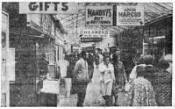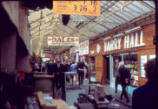
SMITHFIELD: NOW ONLY THE GHOSTS ARE LEFT
writes MICHAEL McRITCHIE
Smithfield's ghost, the spectre of Biddy Farrelly, has seen many changes in her old home over the past century. But none more devastating, senseless or final than the destruction wrought by Tuesday's fire bomb attack.
For Biddy is said to walk every Lammas Fair down Hudson's Entry with her bundle of ballads under her arm, seeking her old lover Luke White who began his fortune in Belfast's old market.
Hudson's Entry is now Gresham Street, a change that Biddy has presumably learned to cope with. But now Smithfield, weekend haunt of countless bookworms and bargain - hunters, is no more.
How the market began. is not clear, but old papers speak of a field much,. favoured by the travelling people - the tinsmiths. Nearby ran a stream which fed a mill pond ... perhaps the Millfield?
By 1780 a thriving market was running at Smithfield, and by the turn of the century the "square" formation was apparent. A big covered shed protected the hide and skin trade in - the centre, while the open street around was lined with houses - and no less than 27 pubs.
Also in the centre was the official weighbridge, with its stack of "fifty sixes" and its uniformed` attendants. As grain and hay was placed on the platform dozens of hangers - on would lay bets on the weight.
Nearby was the handball alley on the site of Andrews' car showrooms, What was lacking in skill was made up for in enthusiasm and brawn, and disputes were settled by a free-for-all.
When the spectators tired of betting they could wander round the forest of pedlars' stalls which surrounded the Square, or cadge a tankard from nearby Dobbins' Brewery. Anything but work, although the chance was there in the several mills around Smithfield.
Friday nights were the busiest time in 19th - century Smithfield, for after the day's trading there was much porter to drink and much to see. clowns grinned from side - show stalls and recruiting parties a marched about with fife and drum.
Highlight of the year was the Grand Lammas Fair when the traders' world d went mad for a week.
Belfast's first prison was built in Ferguson's Entry, off Smithfield, in the 1820s, much to the relief of the good citizens. Until then there was nowhere to put unruly ladies who caused s disturbance in the streets.
The chief constable of the time was quite unhappy about it. "The Constables cannot avoid stating that the violent and outrageous conduct of idle women who collect about the Exchange during the night is extremely insufferable:' he wrote.
"Their conduct is annoying the neighbourhood, injurious to the public peace and is also the means of bringing men of bad and suspicious character about the place."
Now, at least, he could lock them up and the city seems to have been quieter at nights as a result.
For those in Smithfield who did not want to gamble, drink, stand around, or fight, a night at the theatre was the thing. Heffernon's Theatre offered plenty of blood - and - thunder drama for its audience did not appreciate the finer points and was not slow to show it.
In March, 1848, for example, the theatre presented a Grand Oriental Spectacle ... A Gorgeous Phantasy picturing Belshazzar's Feast and the Meeting of Anthony and Cleopatra on the Banks of the Nile. With New Scenery! Correct Costumes! Gorgeous Banners! Terrific Combats! Striking Tableaux!
With all that, who needed Cinemascope? Though one little theatre became a 's music - hall and later a of cinema, with admission reputed to be by four jam - jars, and with natural life of interest to the insect lover.
The first prison became Marshalsee debtors" prison, while nearby was Belfast's first hospital and dispensary.
The roofed market that was destroyed this week was built around the turn of the century. It was old. it was dirty, it was old - fashioned, and it occupied a valuable site. But few Belfast citizens have not enjoyed a browse through its dank caverns.
For some, Smithfield was a way of life. Joe Kavanagh was born in Winetavern Street, near the bus station, 57 years ago, the fifth generation of Kavanagh's to trade there.
His great great grandfather's saddlery business stood on the comer of Millfield, the first of the long connections. Now the "I Buy Anything" slogan is known the world over.
As shops in the same block still smouldered, Joe Kavanagh was making a couple of small purchases from steady customers. But with three of his lifetime's work of five shops in ruins, the market he loved destroyed, the tears were not far from his eyes.
And he is but one of many. The Conlons, the Greers, the Shearers, the Havlins ... all have their roots there.
The most illustrious son of Smithfield was Luke White, born in 1740 in the slum entry of Bell's Lane, now the site of the Post Office. He grew up among the ballad and almanac sellers and learnt to read the books in which he was dealing.
By careful management he built up four shops and married well into Dublin society, becoming High Sheriff. When he died in 1824 he left more than �2 million, in the days when a million was a million.
After family had been provided for, he left �250 a year to his childhood girl friend Biddy Farrelly. Biddy immediately acquired a new husband and style of life, but "died of her riches" within a year.
Biddy, your ghost would be a surprise to us if we saw you in Gresham Street, at midnight. But it would be nothing to the sad surprise you can expect when you walk again this Lammastide, for another part of old Belfast has gone forever.
9/05/1974



